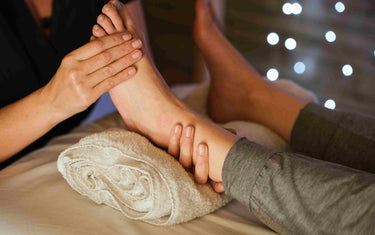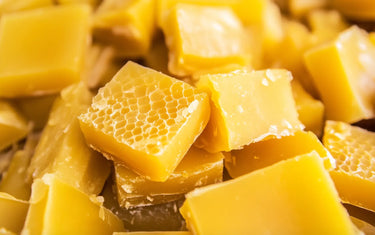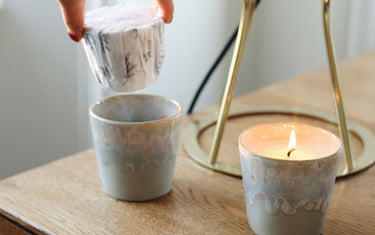5 min read / 25 April 2023 / Laura Garvin Gomez
The Best Foot Massage Oils
Even our feet need a bit of TLC sometimes. Here are some of the best oils for a perfect restorative foot massage.
Share this post

Whether we like to admit it or not, we all appreciate a good foot massage now and then.
That's because our feet are responsible for keeping our bodies up and moving all day long, and that can mean they get tired quite a bit quicker than you'd expect.
While your feet may be strong, they're also worthy of some deserved TLC, especially since they're filled with nerve endings that can affect different parts of our bodies and minds.
Performing a simple foot massage on yourself or others can help rejuvenate these nerve endings and drastically improve your mood, while also providing protection against internal damage and external cracking.
To help get you started, we're running through some of the best ingredients for making your very own all-natural foot massage oil right at home.
What are the best essential oils for foot massage?
Essential oils aren't necessarily needed for a functional massage, but they do make your homemade foot oils a lot more impactful.
Each essential oil carries its own set of benefits for your body and mind, which can not only set a tone of relaxation and peace, but also help tackle stubborn aches. Here are some of our favourites.
1. Lavender oil
Lavender oil is famous for helping us relax, so is the perfect choice for any kind of massage remedy you're looking to create.
It's also an impactful anticonvulsant, which means it can loosen up constricted muscles in the feet and allow for greater relief. This same effect can also help manage any headaches you may be feeling after a long day on your feet.
Learn more about the benefits of lavender essential oil.
2. Geranium oil
Like lavender, geranium oil can also positively impact our moods and help us fall into a more relaxed headspace.
Its strongest asset, however, is its anti-inflammatory effects, which one 2003 study noted could aid in diminishing nerve pain across the body.
Because your feet are so full of nerve endings, implementing a few drops of geranium oil into your massage could successfully eliminate trapped nerves in these areas.
Learn more about the benefits of geranium essential oil.
3. Cypress oil
Herbaceous cypress oil may not be the most common essential oil of the bunch, but its powerful antispasmodic effects make it a superstar when it comes to massages.
By preventing and soothing spasms in the muscles, cypress oil can relieve any pain or tightness located in the feet after a long day. Some sources even suggest that cypress could reduce fluid retention when applied topically.
Learn more about the benefits of cypress essential oil.
4. Lemongrass oil
Lemongrass oil is notorious for getting rid of insects, but did you know it's great for your muscles too?
One 2014 study found that lemongrass oil had a significant effect on localised muscular pain when applied topically, most likely due to its strong anti-inflammatory effects and its generally soothing nature.
Learn more about the benefits of lemongrass essential oil.

What are the best carrier oils for foot massage?
While essential oils may hold all of the scent power, they're far too potent to be used all on their own. For a proper massage, you'll need to dilute them with a carrier oil base. This will make up the majority of your foot oil.
Here are some of the best ones for keeping your feet in good working order.
1. Coconut oil
Fractionated coconut oil stays liquid at room temperature, so is a great option for forming and storing your massage oil.
It's also filled with fatty acids and medium-chain triglycerides (MCTs) that can moisturise and protect your feet from cracking or dryness.
Using coconut oil for feet is also ideal for on-the-go massages, as it can absorb into the skin at a very quick rate (so no leftover greasiness!).
Learn more about the benefits of coconut oil.
2. Jojoba oil
Jojoba oil is one of the most famous massage bases out there, and for good reason.
Its waxy consistency is great for healing dryness, whilst its humectant properties can keep all the goodness of your oils locked into the skin barrier throughout the day.
Jojoba oil is best applied to the feet in the evenings due to its medium speed absorption rate.
Learn more about the benefits of jojoba oil.
3. Grapeseed oil
As a by-product of the wine industry, grapeseed oil is a bit more of an up-and-comer in the massage world, but is a great choice for those who suffer from allergies or sensitive skin.
That's because grapeseed oil is hypoallergenic and is also one of the lightest and fastest-absorbing carrier oils you can find.
It can lock moisture into the skin barrier for up to 16 hours at a time and is also known for reducing inflammation.
Learn more about the benefits of grapeseed oil.
How to massage feet
If you've never performed a massage on feet before, the prospect can seem quite daunting. Thankfully, it's a very easy process with only a few simple steps to keep in mind.
You will need:
- 12 drops of your chosen essential oils
- 3 tablespoons of your chosen carrier oil
Method:
- Wash your feet thoroughly and wipe them dry.
- Sit on your bed with your feet up. If someone else is performing the massage for you, make sure they're supporting your feet with a rolled towel.
- Take a handful of your mixed massage oil and massage the feet one at a time.
- Apply firm pressure throughout, especially on the soles and toes.
- Press each toe with as much pressure as you can, being careful not to overwork the area.
- Massage the length of the foot to target any knots in the bridge.
- Do this process for 5 minutes on each foot.
- Once completed, wipe your feet gently with a towel if you find them too oily. Otherwise, leave the oils to absorb.

Foot massages can be done as often as you'd like, but they work best in the evening time just before bed.
Make sure you're patch testing your massage oil if you've never used the ingredients before, and take care not to hurt your feet by accidentally overworking them.









